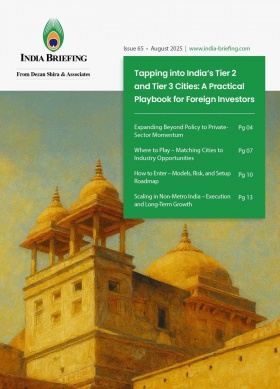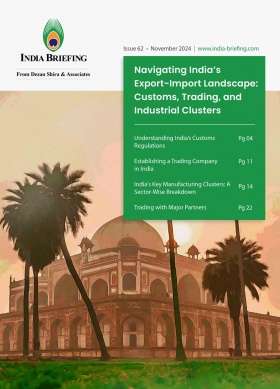Transshipment and Due Diligence in India’s Trade Compliance Landscape
India is not just a major end market but increasingly a node in regional supply chains. As firms look to leverage India’s scale, geographic position, and trade agreements, there’s growing temptation to use Indian ports or bonded zones as “transshipment hubs” or as purported origin‐change points. But that carries regulatory peril.
In particular, Indian customs authorities are refining origin rules and boosting trade compliance powers. At the same time, global importers (e.g. U.S., EU) are scrutinizing Indian intermediaries and routing more intensely for signs of transshipment fraud or origin misdeclaration.
What is transshipment?
Transshipment is the customs-controlled transfer of goods through an intermediate country without local importation or transformation. Only minimal handling is permitted (inspection, limited repacking, consolidation, basic preservation); manufacturing, relabelling origin, or any “substantial transformation” converts the movement into an import or an origin violation.
Indian regulatory changes: Tighter origin controls and scrutiny
1. CAROTAR amendments – “Proof of Origin” replacing “Certificate of Origin”
Effective March 18, 2025, India’s Customs (Administration of Rules of Origin under Trade Agreements) Rules, 2020 (CAROTAR) have been amended. One crucial change: the term “Certificate of Origin” has been replaced with “Proof of Origin.” That is, importers claiming FTA/CEPA preferential rates must hold proof of origin—not just a formal certificate.
This change expands the scope of documentary evidence the customs authorities can demand and raises risk for importers who rely on superficial origin claims. The shift is designed to counter “third-country routing” and misuse of FTAs.
2. Tightening origin verification and FTA misuse controls
India is also tightening customs audits and origin verification under its FTAs. A recent commentary notes that changes aim to reduce misuse of FTA benefits via rerouting, particularly goods from non-FTA origin countries like China being routed through FTA states (e.g., Vietnam or Singapore) to exploit preferential rates.
Some analysts observe that compliance burdens will increase—especially for complex supply chains and goods with multiple inputs.
3. Circular rescission on transshipment via LCS
In April 2025, India’s CBIC repealed Circular No. 29/2020—related to the transshipment of export cargo from Bangladesh via Land Customs Stations (LCS) to third countries.
This rescission signals that India is reexamining prior flexibility permitted to certain transshipment flows, potentially limiting or more strictly policing such routes, influenced by geopolitical factors, among other reasons.
4. India as “Strategic Processing Hub”
In Indian trade commentary, there is a push for industries to locate value‐added processing in India under compliance with origin rules. The idea: rather than mere pass-through, India must be the site of transformation so that “made in India” claims are credible and defensible.
However, some caution that nominal or minimal processing in India—if not meeting origin/ substantial transformation criteria—will attract challenge from other jurisdictions.
Cases illustrating transshipment and origin risks
Below are examples and related scenarios that illuminate transshipment / origin risk.
Case study: Xanthan gum and U.S. anti-dumping evasion
One of the better‐documented transshipment cases involves xanthan gum. U.S. CBP determined that certain imports of xanthan gum had been manufactured in China (thus subject to antidumping (AD) duties) but were transshipped via India or Indonesia and falsely declared as “origin India” or “origin Indonesia.”
One Indian supplier claimed to manufacture it, but CBP discovered that the supplier in fact imported from China and resold without any real transformation. CBP issued a “Notice of Evasion” and imposed the full AD duties that would have applied to Chinese origin goods.
This illustrates a classic transshipment fraud: the route was changed, but not the substance of origin. Because the Indian party did no meaningful transformation, U.S. CBP insisted on Chinese duty classification.
Lesson (for Indian or India-involved actors): Indian intermediaries must maintain clear records and documentary evidence showing genuine transformation if they wish to claim Indian origin. Otherwise, downstream importers may face reversals or liability.
Case study: High-end furniture undervaluation via third-country invoicing
A more domestically focused case: In Mumbai, a high-end furniture business was implicated in a INR 300 million customs duty evasion case. The allegation: imported luxury Italian furniture was undervalued and arranged via shell companies and fabricated invoices from Dubai and Singapore.
Though not strictly transshipment through India, this reflects the same underlying risk: using multiple jurisdictions and questionable documentation to reduce duty exposure.
Case study: Volkswagen India – duty classification and routing scrutiny
India recently issued a large tax / customs notice to Volkswagen India / Skoda‐VW India alleging misclassifications and misuse of import rules. The company is said to have imported much of its car in unassembled (CKD) or parts form and claimed lower duty rates, rather than paying the higher duty for completely built units.
This kind of misclassification and routing (e.g. spread across multiple shipments with components) creates a scenario analogous to transshipment risk—where jurisdictional boundaries and classification differences are exploited.
India Courts Rein in Arbitrary Customs Seizures
The facts (October 2025): An importer (Make India Impex) brought ~56 tonnes of dry dates via Dubai in July 2025. The consignment was cleared by Customs at Nhava Sheva after verification and duty payment. Weeks later, the DRI seized the already-cleared cargo, citing “intelligence” that the dates were actually Pakistan-origin—a category restricted under a DGFT notification dated May 2, 2025. The Bombay High Court said the seizure was arbitrary because no show-cause notice (SCN) had been issued and the action wasn’t backed by contemporaneous records. The Court ordered DRI to issue an SCN within 4 weeks or release the cargo (noting the perishability of dates and the importer’s offer of a bank guarantee).
What the High Court emphasized
- Due process beats “intelligence.” DRI can investigate and enforce bans, but it can’t “take the law into its own hands.” If it wishes to proceed, it must issue a timely SCN; otherwise, continued seizure is illegal.
- Perishables deserve proportionality. With food items, prolonged detention without formal proceedings is disproportionate, especially when Customs had already cleared the goods.
- Prior clearance isn’t immunity—but it matters. Clearance under Section 47 doesn’t bar later action, but any post-clearance intervention must follow the statute (issue SCN, gather evidence, and adjudicate).
How this sits with the wider legal backdrop
- After the Supreme Court’s Canon India review (Nov 2024), DRI does have jurisdiction to issue SCNs—but must still comply with statutory timelines and procedural safeguards. Courts have recently quashed delayed SCNs and admonished adjudicatory drift under Section 28(9).
- Parallel enforcement shows the policy rationale: DRI’s “Operation Deep Manifest” seized multiple containers of Pakistan-origin dry dates/cosmetics routed via Jebel Ali and misdeclared as UAE origin—illustrating genuine risks that require firm, but lawful, action.
Practical takeaways for importers/exporters
- Document origin credibly up-front. If you’re routing via hubs (e.g., Dubai/Jebel Ali), maintain supplier affidavits, mill/packing lists, shipping evidence, and country-of-origin proofs that will withstand scrutiny.
- Track the clock after a detention/seizure. If no SCN arrives within a reasonable period (and especially where goods are perishable), seek judicial relief; courts will test the lawfulness and proportionality of seizures.
- Be audit-ready for re-verification. Even post-clearance, authorities can revisit origin/valuation. Keep consistent documents (through B/L, invoices, packing lists, seals) to avoid extended holds.
- Don’t conflate policy with process. Import bans and origin restrictions are real (e.g., Pakistan-origin items), but enforcement must follow procedure; you can both cooperate and insist on due process.
Integrating India into the transshipment due diligence framework
|
Stage |
India-specific considerations |
Best practices |
|
Pre-shipment / Design |
If using Indian ports or bonded zones as transit or consolidation hubs, ensure strict adherence to Indian customs and origin rules (CAROTAR). |
Map every leg. For shipments passing India, require evidence that India’s customs will treat the flow as transshipment, not import. Engage Indian customs counsel. |
|
Supplier and intermediary vetting |
Indian exporters or intermediaries may claim origin, but underlying inputs might be non-originating. In many FTAs, “value add / transformation” thresholds matter. |
Request bills of materials, input sourcing ledgers, production logs, process flow diagrams. Confirm that the operations in India meet FTA origin criteria. |
|
Transshipment documents (India node) |
In India, there is no widely used “Certificate of Non-Manipulation (CNM)” like in ASEAN. But documentation and customs seals are critical. Also, Indian customs may treat some transit flows more strictly. |
At Indian node, maintain: customs transit permits, seal logs, bills of lading, internal handling records. Where possible, get an Indian customs certification or endorsement. |
|
Post-shipment / Audit defense |
Importers in U.S., EU, etc., will trace backward. If Indian intermediary cannot credibly show transformation, the entire chain may be reclassified. |
Maintain audit decks containing origin proofs, process descriptions, internal inspections. Conduct internal mock origin audits. Engage forensic review of chain flows through India nodes. |
A hypothetical cross-border supply chain through India
Imagine a company A in China producing photovoltaic glass. It sells to company B, an Indian trading company, which simply repackages and consolidates shipments, then re-exports to the U.S., claiming “Made in India.” U.S. CBP, during an audit, demands proof of transformation. Company B cannot demonstrate any value addition beyond repackaging. CBP deems origin as China, imposes antidumping duties, and penalizes the U.S. importer.
To prevent this outcome, company A and its downstream partners should have designed the India leg as a bona fide manufacturing or tempering process that meets origin thresholds under U.S., India, and FTA rules—backed by process logs, machine time records, input sourcing declarations, and customs transit records in India.
Strategic insights for global supply chain managers
Don’t treat India as a “backdoor route” without justification: Routing through India solely to claim origin or avoid duties invites scrutiny and rebuttal. Unless India adds meaningful transformation, downstream authorities may disregard the routing.
Proactively document transformation processes in India: Time stamps, machine logs, input sourcing, labor records, quality inspection, and process flow evidence are invaluable. Even for small operations, traceable records can make or break the origin claim.
Leverage compliance partnerships in India: Indian trade, customs, legal and logistics teams should be integrated in planning. Use India‐based customs consultants to pre-clear transshipment plans and review risk.
Anticipate Indian origin audits & origin verification requests: With CAROTAR revisions, Indian customs may demand additional “proof” beyond certificates. Be ready to provide internal records, traceability data, and justifications.
Run origin simulations and “stress tests”: Prior to executing a transshipment route via India, simulate worst-case audits from major import jurisdictions (U.S., EU). Test whether the Indian node can withstand a deep dive.
Maintain full-chain traceability and consistency: Across all documentation (purchase orders, bills of lading, invoices, COOs / proof of origin), HS codes, quantities, values should match. Even small mismatches or misalignment can raise red flags.
Stay alert to regulatory shifts in India: Recent circulars and shift in origin terminology remind us that the regulatory landscape is evolving. Maintain compliance alerts for Indian customs updates.
About Us
India Briefing is one of five regional publications under the Asia Briefing brand. It is supported by Dezan Shira & Associates, a pan-Asia, multi-disciplinary professional services firm that assists foreign investors throughout Asia, including through offices in Delhi, Mumbai, and Bengaluru in India. Dezan Shira & Associates also maintains offices or has alliance partners assisting foreign investors in China, Hong Kong SAR, Vietnam, Indonesia, Singapore, Malaysia, Mongolia, Dubai (UAE), Japan, South Korea, Nepal, The Philippines, Sri Lanka, Thailand, Italy, Germany, Bangladesh, Australia, United States, and United Kingdom and Ireland.
For a complimentary subscription to India Briefing’s content products, please click here. For support with establishing a business in India or for assistance in analyzing and entering markets, please contact the firm at india@dezshira.com or visit our website at www.dezshira.com.
- Previous Article India-UK Social Security Agreement: A Breakthrough for Indian Professionals and Employers
- Next Article CBIC Automates IFSC Code Registration to Boost India’s Trade Facilitation








